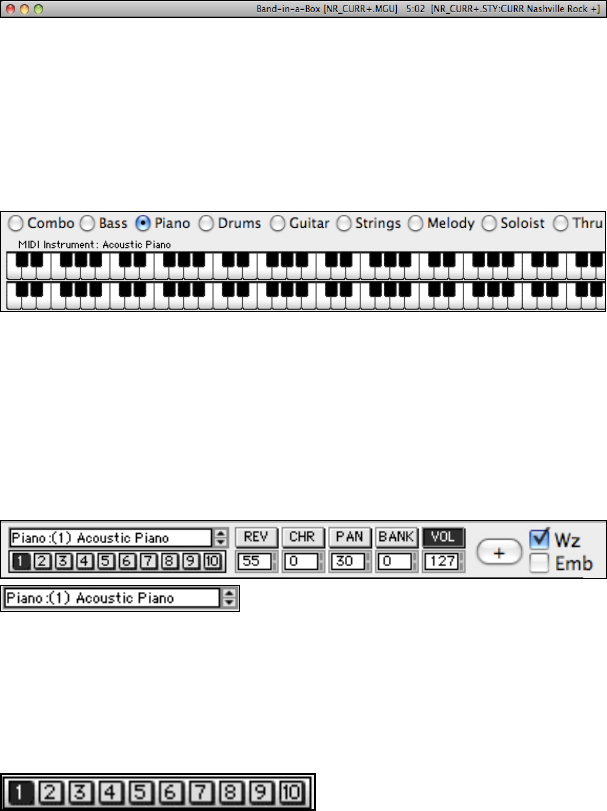User Guide
Table Of Contents
- PG Music Inc. License Agreement
- Table of Contents
- Chapter 1: Welcome to Band-in-a-Box!
- Chapter 2: QuickStart Tutorial
- Chapter 3: Band-in-a-Box 2010.5 for Macintosh
- Welcome to Band-in-a-Box 2010.5
- New Features in Band-in-a-Box 2010
- More New RealTracks
- QuickStart Tutorial
- Quick Song Settings
- Save Default Mix
- Improved Audio Rendering
- DAW Plug-in Mode
- Freeze Tracks
- RealTracks Enhancements
- New Favorite Songs/Styles Dialog
- Rendering Tracks
- StylePicker Enhancements
- New in the StyleMaker
- Chapter 4: The Main Screen
- Chapter 5: Guided Tour of Band-in-a-Box
- Chapter 6: Band-in-a-Box PowerGuide
- RealTracks
- RealDrums
- Song Settings
- The Chordsheet
- Chord Preview/Builder
- MIDI file “Chord Wizard”
- Applying Styles
- The StylePicker
- Playing, Pausing, and Stopping Songs
- Changing Volume, Panning, Reverb, Chorus, Bank
- Freeze Tracks
- Saving Songs
- Preferences – User Settings
-
- Show Chords with push/rest chars
- Metronome During Recording
- Harmony Volume Adjust
- OK to Load Style with songs
- Write Guitar part on 6 channels
- Turn External Keyboard’s Local On at end of session
- OK to beep with messages
- OK to prompt to reduce/expand
- For Roman Numerals in minor keys, use relative major
- Save Button on main screen works as Save As
- Name MIDI files with .MID extension
- Allow larger fonts on Chordsheet
- Color for Chordsheet Area
-
- Other Editing Features
- MIDI Setup
- The JukeBox
- Chapter 7: Notation and Printing
- Chapter 8: Automatic Music Features
- Chapter 9: Recording Tracks
- Chapter 10: Audio Features
- Chapter 11: Wizards, Tutors, and Fun
- Chapter 12: User Programmable Functions
- Chapter 13: CoreMIDI and Apple DLS Synth
- Chapter 14: Reference
- PG Music Inc.
- Index
- Registration Form

Chapter 4: The Main Screen
32
Status Bar
The first thing to note is that the name of the song that is open is identified in the window title at the top of the
screen along with the name of the style. This feature is handy when you want to know the status (and the title) of
your song and the style in use at a glance. You'll also see the length of the song in minutes and seconds, this updates
if you change the tempo and press the [Play] button.
The file name in the status bar will have an asterisk * added if the file has been changed.
Synth Window / Piano Keyboard
The Piano Keyboard
This keyboard displays the notes that are being played by all instruments on various parts of the piano keyboard
during playback (except drums). The name of the currently selected part is shown just above the keyboard.
When playing along or recording on the MIDI Thru the notes are displayed on the keyboard.
Synthesizer Window
Part Settings
The Bass/Piano/Drum/Guitar/Soloist/Strings/Melody and Thru buttons are referred to as Parts. Settings that can be
changed for an individual part include Reverb, Chorus, Pan, Bank, Volume, and Instrument. To change a setting for
one of the parts:
- Select the Part by mouse clicking on the part name.
- Change the desired parameter to affect the new setting.
The Instrument Panel shows the current instrument for the selected part.
You can access your patches with ease through the “patches popup” menu. To access this menu, simply click on
the instrument box you would like to change (i.e. Piano, Bass, Sol, etc.), move your mouse pointer over the
instrument panel box (i.e. Piano: (1) Acoustic Piano), and click anywhere on the instrument name. Then select the
new patch from the popup menu.
Clicking on the up ▲ and down ▼arrows will move up and down the list of instrument patches one at a time.
The Favorite Instrument panel allows you to assign up to 10 of your favorite instruments for each of the 8 parts
(Bass, Piano, Drums, Guitar, Strings, Melody, Soloist, and Thru). Once assigned, these instruments can be quickly
and easily set.
Always use General MIDI instrument numbers, even if you use a custom patch map. It will handle the conversion
to your synth’s non-GM patch numbers, so you should always enter GM patch numbers for the favorite instruments.
(Favorite Instruments)










